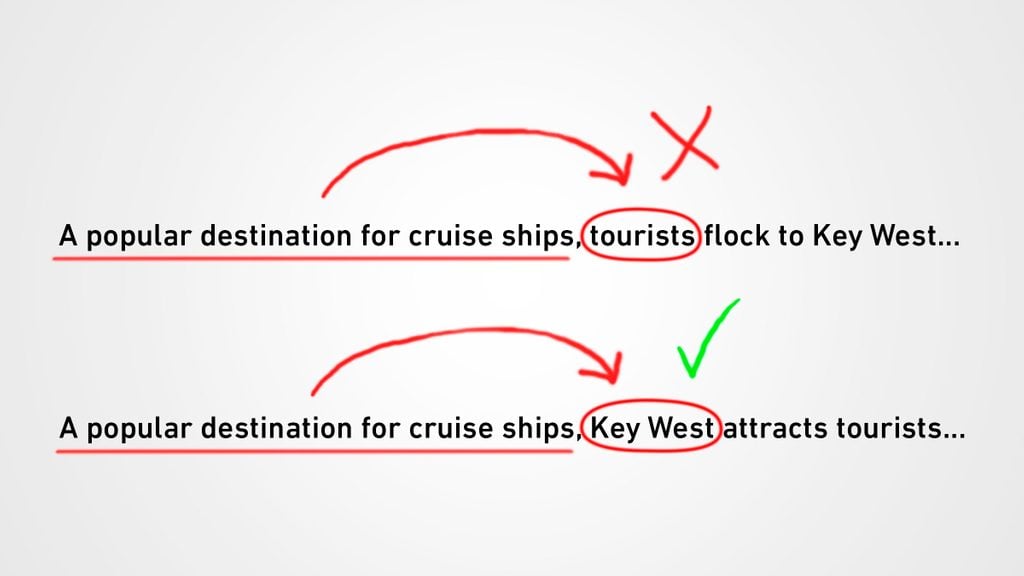Misplaced Modifiers: The Grammar Mistake You Didn’t Know You Were Making
Updated: Mar. 28, 2022

Why are misplaced modifiers such a common grammatical error? Plus, what's the difference between a misplaced modifier and a dangling modifier?
“A popular destination for cruise ships, tourists flock to Key West to eat key lime pie and visit Ernest Hemingway’s house.” Is this sentence grammatically correct? It might seem like it is, on first read. But take a look again. According to this sentence, Key West is not the popular destination—the tourists are! That’s because “tourists” is the subject of the sentence, even though the introductory phrase—the modifier—is clearly meant to be about Key West.
To fix this sentence, you could keep the modifier, but “Key West” would need to become the subject of the sentence. So you could say: “A popular destination for cruise ships, Key West attracts tourists who want to eat key lime pie and visit Ernest Hemingway’s house.” You could also replace the modifier: “In search of key lime pie and Ernest Hemingway’s house, tourists flock to Key West.”
This is a fairly obscure grammar rule that you probably touched on briefly in English class or encountered on the SATs. But it’s very easy to write a sentence with a misplaced modifier, without even realizing it. It makes sense that it’s one of the grammatical errors even smart people make. How can you avoid this common grammar error?
What is a misplaced modifier?
Well, first of all, what’s a modifier? A modifier is a single word, a group of words, a phrase, or a clause that describes (or “modifies”) something. Adjectives and adverbs, as well as adverbial and adjective phrases and clauses, can be modifiers. For instance, in both of the following sentences, the modifier is in bold and describes the color of the fish. 1.”He caught a silver fish” (adjective). 2. “As silver as a new nickel, the fish he caught shined in the sun” (adjective phrase).
When a modifier is misplaced, it’s unclear what the modifier is meant to modify. Sometimes, it may even have nothing to modify. Though introductory phrases and clauses can often be misplaced modifiers, as in the Key West example, modifiers can be misplaced anywhere in a sentence. There are also a couple of different types of misplaced modifiers. The Key West example is what’s called a dangling modifier. Test how well you know rules like this with this tricky high school grammar quiz.
Misplaced modifier vs. dangling modifier
A dangling modifier is a type of misplaced modifier; all dangling modifiers are misplaced modifiers (but not vice-versa). When a modifier is dangling, it describes the wrong thing, as in the Key West example. Consider this sentence, too: “Upon arriving at the edge of the Grand Canyon, the natural beauty was astonishing.” What’s doing the “arriving” described in the intro clause? Not “the natural beauty,” as the current sentence would suggest. This sentence differs from the Key West one because, in the first Key West sentence, the correct subject is still in the sentence (“Key West”), while in the Grand Canyon version, the correct subject is not in the sentence (whoever was astonished by the natural beauty, presumably “I”).
Unlike the sentence about Key West, where the modifier described the wrong thing, in this sentence, the modifier describes … nothing. Nothing or no one in this sentence is doing the act of arriving that the modifier mentions. You might fix this sentence by saying, “Upon arriving at the edge of the Grand Canyon, I was astonished by the natural beauty.”
Ambiguous misplaced modifier examples
Another type of misplaced modifier is an ambiguous, or squinting, modifier. The following sentence has one: “Eating fried clams slowly makes me feel sick.” Since “eating fried clams slowly” makes sense, and so does “slowly makes me feel sick,” it’s ambiguous whether the modifier, “slowly,” means the speed of the eating or the speed of the sick feeling. Many times, fixing a misplaced modifier requires rearranging the sentence to make sure it’s clear. In this case, you could say, “I slowly start to feel sick when I eat fried clams.”
Admittedly, some ambiguous modifier errors leave no doubt as to what the modifier is referring to. For instance, if you say, “Kayla bought a green baby’s outfit at the store,” technically it’s not grammatically clear whether “green” is modifying “baby” or “outfit.” But chances are you’re not talking about a green baby.
Bottom line: To avoid misplaced modifiers, make sure that any descriptive word, phrase, or clause in your sentence is actually describing what it’s supposed to. If you’re starting a sentence with a modifier, make sure that the subject that follows is the thing the modifier is describing. It’s definitely easier said than done, but with a little practice, you can master it, just like these other most confusing grammar rules in the English language.
